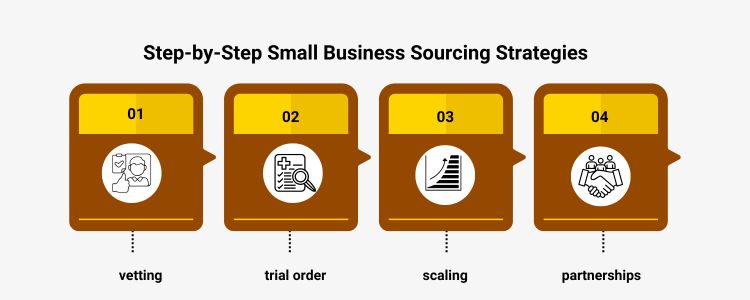How Small Businesses Can Thrive with International Product Sourcing
In a time of borderless commerce, small businesses can now consider global opportunities. Just a few decades ago, international sourcing was limited only to multinational corporations. Small businesses now regard international sourcing as a viable growth strategy. Through accessing foreign suppliers, business owners can save money, expand product offerings, and remain competitive. However, using the global marketplace comes with the need for strategic planning, good decision-making, and managing the balance between opportunity and risk.
This article explores the complexities of international product sourcing, what challenges small firms may face, and what small firms can do to succeed in global supply chains.
Why International Product Sourcing Matters for Small Businesses
Global trade liberalization, digital platforms, and improvements in logistics have lowered barriers to entry for small firms. Here are some examples:
- Cost competitiveness: Gaining access to materials or finished goods from lower-cost economies allows small firms to increase margins, while still providing a quality product.
- Product diversity: International sourcing enables firms to sell niche or innovative products not available locally.
- Scalability: International suppliers give small firms a means to take advantage of global production capacity to manage fluctuations in demand.
Opportunities in Global Procurement for Small Businesses
It’s vital for small businesses to also compete globally in procurement in competitive industries – these are just a few advantages:
- Broader Supplier Base: Small businesses can create resilience in this area by diversifying their vendors.
- Technology Enablement: Digital platforms such as Alibaba, Global Sources, and IndiaMART allow even micro businesses to procure and negotiate with suppliers internationally.
Access to innovation: International suppliers can bring the same advanced technology or designs to market before the domestic market does.
The aggregate opportunities create an ecosystem that enables beckoning global procurement to be a strategic lever and not just a cost reduction measure.

Challenges in International Product Sourcing
While there are advantages, internationally sourcing also entails the following risks:
- Quality assurance: Assessing standards and the credibility of suppliers is still difficult from across the ocean.
- Logistics complexities: Shipping delays, customs duties, and documentation can compound operational challenges.
- Currency and payment risks: Exchange rate variations can greatly impact landed costs.
- Cultural and communication gaps: Differences in expectations or miscommunications can affect business relationships.
As outlined above, small businesses need structured strategies for mitigating these risks, from due diligence to long-term partnerships with suppliers.
Small Business Sourcing Strategies: Building a Robust Framework
Creating sourcing strategies for small businesses begins by knowing your purpose. Companies need to establish if they are seeking cost savings, product development, or supply chain diversification. Successful sourcing strategies include:
- Supplier vetting: Using third-party inspection companies to conduct audits and verify the quality of products.
- Scaling up slowly: Begin with limited trial orders before committing to sourcing in larger units.
- Local-global mix: Have a combination of both domestic and international suppliers to provide flexibility.
- Negotiation training: Train procurement managers to read, review, and negotiate cross-border contracts.
These examples will enable small firms to be flexible while accepting some of the risks associated with international trade.
Small Business Global Supply Chain: A Competitive Edge
In our unprecedented economic environment, a resilient small business global supply network is imperative. Recent global disruptions (pandemic, shipping crisis, etc.) showed the fragility of overly relying on singular geographies. Small businesses can mitigate against this issue by taking action in these three areas:
- Nearshoring and friendshoring: Find geographically shades of supply chain alternatives closer to home to minimize transit time.
- Inventory planning: Apply demand forecasting tools to manage and reduce stockouts and excess carrying costs.
- Technology integration: Implement cloud-based supply chain management software to enable transparency and real-time tracking of shipments.
Once small firms take the above actions, supply chains shift from a competitive disadvantage to a competitive advantage.
Best Countries for Small Business Sourcing
The most favorable countries for sourcing small business products will depend largely on the specific product category, cost-effectiveness, and reliable sources. There are several notable film sourcing hubs, including:
- India – a stronghold for textiles, crafts, and IT-enabled services, with increased attention on sustainable practices.
- Vietnam – a rising star for apparel, footwear, and furniture products, benefiting from low wages and trade agreements.
- Bangladesh has a long history of low-cost production, particularly in mass-scale apparel manufacturing.
- Turkey and Mexico have a strong locational value for companies seeking proximity to Europe and North America, reducing lead times.
For small businesses, balancing cost savings with supplier credibility is crucial while choosing sourcing destinations.
Sustainable International Product Sourcing Strategies
A rising number of consumers are questioning companies about the ethical and environmentally friendly supply chain of their products. Implementing international sourcing strategies that benefit globally can support the viability of the business long-term. Major components of sustainability in the supply chain include:
- Green certifications: Working with suppliers who have ISO, OEKO-TEX, or GOTS certification.
- Ethical audits: Ensuring that companies can verify their labor practices do not violate an established international benchmark, such as fair wages, safe spaces for production, etc.
- Carbon footprint reduction: Considering using sea freight instead of air freight and would support companies that are investing in Carbon Offsets.
- Circular supply chain: Working with suppliers that are promoting and encouraging recycling and upcycling.
Being sustainable is not just for protecting a corporate brand from a reputation point of view; it can be a new opportunity if the market demands more sustainable products.
How Technology Empowers International Sourcing
Digitalization is transforming small companies going abroad:
- Blockchain: Provides traceability and authenticity throughout the supply chain.
- AI-powered analytics: Enables demand predictions and optimized ordering.
- E-commerce platforms: Simplify supplier discovery and reduce barriers to entry.
This confluence of technologies provides more transparency and accessibility to international sourcing than ever before.
Case Studies: Small Firms Going Global
- A boutique fashion label in Munich expanded by using fabric from India first, before opening a manufacturing facility close to home, offering quality-rich fabrics at a realistic price.
- An electronics start-up in Brussels had a supplier network in Vietnam to use for prototypes intended to speed up innovation at a lower price point.
- An artisanal food products exporter in the United Kingdom used international suppliers certified for fair-trade status, which meant a strong ethical brand identity could emerge.
These examples demonstrate that size is no longer a barrier to global integration.
Conclusion: Thriving Beyond Borders
For small businesses, the route ahead for sustainable growth is global thinking, strategic action. International product sourcing for small businesses is less about reducing costs and more about securing innovation, building resilience, and developing competitive advantage.
By integrating sourcing decisions with long-term business goals, a commitment to sustainability, and employing digital means to identify and track sourcing strategies, small enterprises can survive and thrive in global trade.
In an evolving world that prizes agility and forethought, international sourcing is not just a choice; it is a necessity.
Frequently Asked Questions (FAQ)
Electronics, pharmaceuticals, renewable energy, and textiles will all be drivers.
India provides cost-effectiveness, skilled labor, and positive policy choices, making India a secure addition to global supply chains.
Textiles, pharmaceuticals, agro-processed products, and electronics.
Very competitive due to regulatory compliance, quality, and cost parity with similar products, and benefits from a tariff-free trade agreement.
Suppliers provide flexibility, scale, and reliability to global buyers and thus mitigate the supply chain disruption inherent in supply chain risks.
Great people, great policy, together with a variety of industry clusters.









